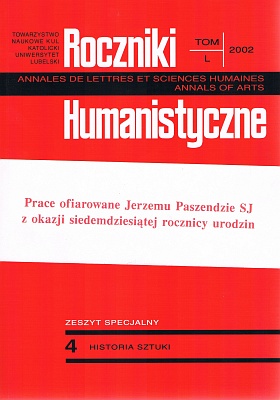Four Figures in the Cracow St Barbara Church
Abstract
Pointing to the important role played by the Jesuit St Barbara church in organization of spiritual life in Cracow Gajewski draws the reader’s attention to the fact that modernizations of the church interior conducted in the third decade of the 18th century and in the years 1764- 1767 were correlated in time with periods of intensification of the cult of Cordis Jesu and with aspiration to enliven the cult of the Virgin Mary the Dolorous. Pronouncements by the Polish nation represented by its ruler (August II in 1726) and the hierarchy of the Polish Church (1726, 1765) that the cult of Cordis Jesu should be recognized by the Holy See were connected with it. Participation of Polish Jesuits in those actions was understood and justified, as it was closely connected with the problems dealt with in writings by our Jesuit ascetic-mystic teologians as well as in Rev. Kasper Drużbicki’s works, precursory in the European scale.
Gajewski links the modernization of St Barbara church conducted in the twenties of the 18th century (among others, the Jesuit sculptor Dawid Heel’s works) with sculpting (after 1726; probably around 1729-1731) four figures: of St Anna, St Joachim, St John the Baptist and John the Evangelist. Up till now in the subject literature the figures were dated to 1764-1767. Gajewski recognizes Johann Elias Hoffman, a sculptor coming from Vienna, and his younger brother Heinrich co-operating with him, as the ones who are the authors of the figures and of the sculptured decoration of the altar (that has not been preserved to our times) of the Virgin Mary the Dolorous. Johann Elial Hoffman, an artist using a distingushed, classicizing style that was based on the Italianized Vienna sculpture and probably the sculpture of the Veneto region, worked in Poland from 1721 until his death in 1751 (he died in Puławy near Lublin). Gajewski explains the lower standard of the sculptures representing St Joachim, St John the Baptist and St John the Evangelist with participation of the younger Hoffmann – Heinrich in their realization; Heinrich was less talented and his preparation for the job was worse.
In conclusion Gajewski draws the reader’s attention to the mechanisms that rule Cracow’s art market and hypothetically points to the significant participation of the townspeople factor in organizing and functioning of the market for orders.
Copyright (c) 2002 Roczniki Humanistyczne

This work is licensed under a Creative Commons Attribution-NonCommercial-NoDerivatives 4.0 International License.





